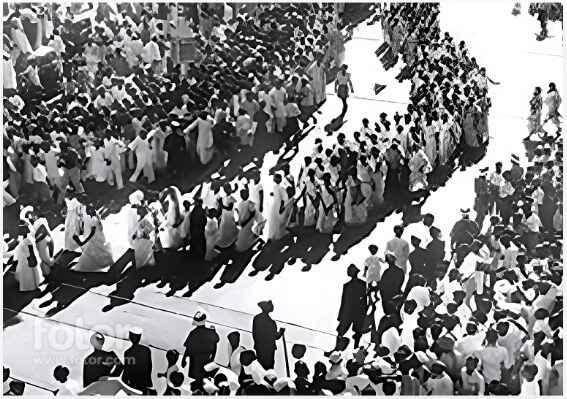Updated February 9, 2023
Quit India Movement of 1942
The Quit India Movement, also known as Bharat Chodo Aandolan, initiated under the leadership of Mahatma Gandhi, took place on 8th August 1942, during World War II, to call an end to British rule in India, which was also part of the Civil Disobedience Movement at the All India National Congress Committee’s session in Bombay.
(Image credit: amsadmin.amritmahotsav.nic.in)
The Quit India Movement was a campaign based on Satyagrah to establish Indian sovereignty through peaceful violation of laws and nonviolent resistance. Through his speech that he delivered at the Gowalia Tank Maidan, which is now August Kranti Maidan, Mahatma Gandhi guided his mantra, “Do or Die-We shall either free India or die in the attempt; we shall not live to see the perpetuation of our slavery, to the people.”
When the Quit India Movement was going on, Aruna Asaf Ali, known as the “Grand Old Lady of the Independence Movement,” raised the Indian flag at the Gowalia Tank Maidan. She was an essential part of India’s fight for freedom. Yusuf Meher Ali, freedom fighter, socialist leader, and then Mayor of Bombay in 1942, was a member of the underground Movement and the Quit India Movement, which coined the term “Quit India.”
Resolution of Quit India Movement
The meeting agreed to the following solutions:
- An immediate end to the British rule in India
- Declarations of the commitment to free India
- Defend all kinds of Imperialism and fascism
- Formation of the provisional government in India after the British withdrawal
- Sanctioning Civil Disobedience Movement against British rule.
Gandhi’s Instruction
- Government employees – Instead of resigning, vow your adherence to the INC.
- Landlords/ Zamindars – If the landlords/Zamindars are pro-government, do not pay the rent; if they are anti-government, pay the agreed-upon rent.
- Students – If confident enough, they can leave their studies and join the INC.
- Princes – stand behind the people and embrace their sovereignty.
- Soldiers – Stay with the army but don’t fire on your comrades.
- People of princely states – support the monarch if he is anti-government; declare yourselves Indian citizens.
Causes
1. Failure of Cripps Mission
- The main reason for the Movement was the failure of the Cripps Mission.
- The Cripps Mission proposal failed to satisfy Indian Nationalists, eventually becoming propaganda for the US and Chinese consumption.
- The Congress did not like the offer of dominion status instead of a provision for complete Independence.
2. Word War II
- The involvement of Indians in World War II without initial consultation was another main reason.
- In 1939, during the Second World War, Japan had enough reason to invade India, where Japan was a part of the Axis Powers fighting the British in the wars. Mahatma Gandhi felt that if the British left India, Japan would not gain the northern frontiers of India.
- The high prices of essential commodities in the difficult times of war and British setbacks led to the Quit India Movement’s call.
Phases of Quit India Movement
The Quit India Movement is viewed from its inception to the end in three phases.
a) First Phase
- Strikes, rallies, and riots spread across the whole country, and workers showed opposition by refusing to work in the factories
- The general public attacked the government buildings and forcibly hoisted national flags
- Students dropped out of school and worked as raw agents for the underground networks
- All members of the Congress Committee got arrested.
b) Second Phase
- The second phase took a violent and aggressive turn
- This took rampant destruction of railways tracks, and communication systems and attacks on government buildings
- This phase involved new leaders in underground activities guiding the distribution of arms and ammunition.
c) Third Phase
The third phase of the Movement formed many independent and parallel governments at Tamluk, Satara, and Ballia.
Impacts
The Movement gave rise to various responses in the form of Positive and Negative impacts.
Positive Impact
- Rise of Future leaders Ram Manohar Lohia, J.P Narayan, Biju Patnaik, and Aruna Asaf Ali took care of activities.
- Women like Usha Mehta’s active participation helped set up an underground radio station to lead the awakening of the Movement.
- The Movement emerged with a sense of unity, brotherhood, and the rise of Nationalism. It led young schools and college students to join the Movement.
- The Movement paved the way for Independence as the British realized India would be ungovernable in the long run due to World War II’s high cost.
Negative Impact
- Over 100000 people were involved in the Quit India Movement, and significant leaders like Mahatma Gandhi, Jawaharlal Nehru, and Sardar Vallabhai Patel got arrested.
- The Movement led to Violence where there was mass flogging; people were lathi-charged, villages burnt, heavy fines imposed, nearly 10000 people were shot dead in the police firing, and even women and children were not spared by the British.
- The Violence led to damage to government property, cut electricity lines, set many buildings on fire, disrupted communication and transportation, and many more.
- Opposition parties like the Muslim League, the Communist Party of India, and the Hindu Mahasabha were not in support of the Movement.:-
- The Muslim League opposed the British dividing the Nation first before leaving India.
- The Communist Party supported the British as they were allied with the Soviet Union.
- The Hindu Mahasabha opposed the Quit India Movement as it would have created security issues during the war.
Conclusion
The Quit India Movement ended in 1944, which changed the dynamics with the British government and led to the way of India’s Independence. The freedom struggle was owned by “We the People,” who fought for Independence in this Movement.
Recommended Articles
We hope that this EDUCBA information on “Quit India Movement” was beneficial to you. You can view EDUCBA’s recommended articles for more information,

